| Palaeos: Paleozoic |  |
Late Devonian Epoch |
| Devonian Period | Frasnian Age |
| Page Back | Back: Givetian | Back: Middle Devonian | Up: Late Devonian | |
| Page Next | Next: Famennian | Next: Mississippian |
|
Timescale |
| Palaeos: Paleozoic |  |
Late Devonian Epoch |
| Devonian Period | Frasnian Age |
| Page Back | Back: Givetian | Back: Middle Devonian | Up: Late Devonian | |
| Page Next | Next: Famennian | Next: Mississippian |
|
Timescale |
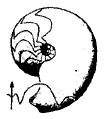 |
Manticoceras
(Middle Frasnian to earliest Famennian) |
The Frasnian epoch saw the evolution of quite distinct,
and short-lived, goniatite groups belonging to the Gephuroceratacea, and
Pharcicerataceae, which are united by the distinctive proliferation of
umbilicsl lobes. Some of these genera are illustrated at the left. A cosmopolitan
distribution for the Devonian was achieved in the Frasnian by Manticoceras
and its relatives, the fossil shells of which are known from North America,
Asia and Australia, as well as the rich record in Europe and North Africa.
left Frasnian ammonoids, illustrating shell form
and suture lines: Body chamber length not necessarily correctly indicated.
Drawings from M. R. House, "Devonian Goniatites", in A. Hallam, ed. Atlas
of Paleogeography, p.100
|
 |
Beloceras
(Middle to Late Frasnian) |
|
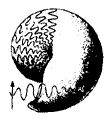 |
(early Frasnian) |
The earliest Frasnian Lunulicosta zone is characterized by genera such at Pharciceras, Synpharciceras, Timanites, Epitornoceras. Koenenites and distinctive species of Ponticeras and Tornoceras. Europe and North Africa have the fullest record
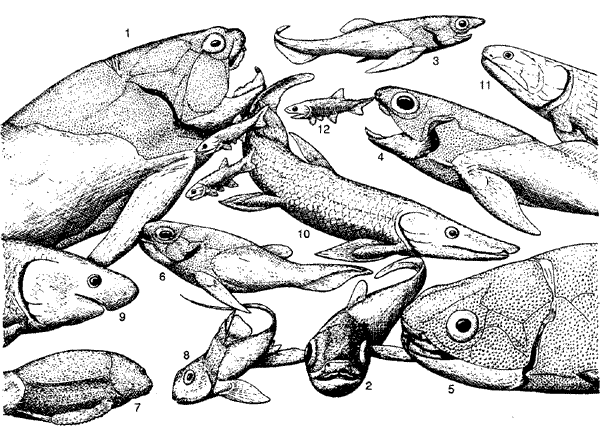
Reconstruction from Philippe Janvier's book Early
Vertebrates, (1996, Clarendon Press, Oxford) p, 13
 |
Manticoceras
(Middle Frasnian to earliest Famennian) |
Middle Frasnian ammonoid faunas, that is those of the Cordatum
zone, are characterized especially by the genus Mantioceras and Beloceras,
although both continue later, the former with distinctive late species.
Mantioceras
especially is characterized by a cosmopolitan distribution, being known
from every continent except South America (and the absence there would
be due to lack of fossilferous localities rather than actual biogography).
Beloceras has a more restricted range, but is still known from the
Chinese (Southern Kwangsi), Euramerica (New York) and Gondwana (Western
Australia) terranes. This incidentally was also a time of cosmopolitan
brachiopod and fish distribution. It would seem that the land masses
had come into closer proximity, allowing migration between previously separate continental shelves.
left Middle Frasnian ammonoids, illustrating shell form and suture lines:: Body chamber length not necessarily correctly indicated. Drawings from M. R. House, "Devonian Goniatites", in A. Hallam, ed. Atlas of Paleogeography, p.100 |
 |
Beloceras
(Middle to Late Frasnian) |
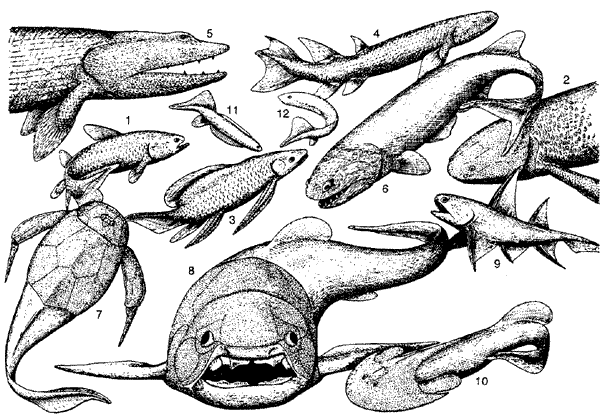
The Miguasha fish fauna (Escumenic fish fauna of Quebec (north central
Euramerica)
presents a remarkable diversity of early vertebrates, although chondrichthyans
(sharks), which are largely represented in other localities of similar
age, are absent. There is a variety of lobe finned fishes (sarcopterygia),
belonging to five major taxa: the actinistians
(1. Miguashuia). porolepiforms
(2, Holoptychius), lungfishes
(3, Scuamenacia), Osteolepiformes
(4, Eusthenopteron), and
elpistostegalians
(5, Elpistostege),
which are the immediate ancestors of the tetrapods.
Ray-finned fishes (Actinopterygii)
are rare with only one large form (6 Cheirolepis). In addition,
there are archaic elements, such as the antiarch
(7, Bothriolepis) and arthrodire
(Plourdosteus) placoderms
as well as acanthodians
(9, Diplacanthus). and the youngest known osteostracan
jawless
fishes (10, Escuminaspis) Two anaspid-like naked jawless fishes
(11. Endeiolepis, 12. Euphanerops) may be close relatives
of the extant lampreys. These fishes lived in an estuary surrounded by
ferns.
"(studies of plant assemblages from New York state show that) During the middle of the Frasnian, significant floristic changes appear to have occurred, but the extent to which these changes reflect differences in the depositional settings is unclear. Aneurophytalean progymnosperms declined precipitously in abundance, and diversity drops from six to two genera in the New York section. Archaeopterid progymnosperms increased in abundance and diversity. Herbaceous "ferns" and lycophytes became rare to absent, although lycopsid trees remained. The landscape was altered drastically by the subsequent rise of Archaeopteris forests. These dominance-diversity changes have been attributed to the same factors that ultimately caused the Frasnian- Famennian marine extinctions (Scheckler 1986a), possibly climatic change associated with the onset of Gondwanan glaciation (Veevers and Powell 1987; Crowley and North 1988). The decline in diversity and major shifts in dominance patterns continued into the late Frasnian."
During the later Frasnian the diversification gradually declines and reaches its minimum at the F-F boundary (the extinction event). Two entire orders, the Atrypida and Pentamerida, die out completely, as do many Orthid and Stropheodontid families.
Knowledge of Late Frasnian goniatite faunas is rather sparse. The
Holzapfeli zone faunas were first described from Germany and have been recognized
in Devon, England, and in eastern North America. Their occurrence
in Gondwana (North Africa) has been doubted (Petter, 1959). Bogoslovski
(1969) recognizes Late Frasnian faunas in the Rudnyi Altai and the Urals.
The species which characterize this level belong to Archoceras, Aulatornocetas,
Crickites and Manticoceras, that is, genera with a longer range
than the Holzapfeli zone. Nonetheless, it would seem that there
is a restriction in the distribution of Late Frasnian ammonites, although
this is a subject that needs a more detailed study.
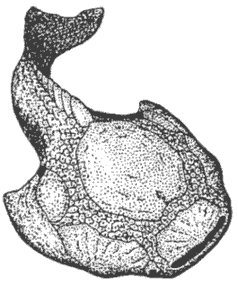
Psammolepis, the last and largest of the ostracoderms (Jawless fish). This harmless bottom-dweller reached two meters in length. Reconstruction from Philippe Janvier's book Early Vertebrates, (1996, Clarendon Press, Oxford) |
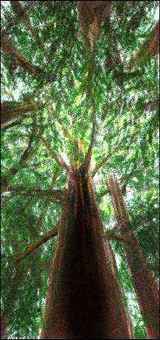
"Late Frasnian plant communities also are known from localities in New York (Scheckler 1986a). The most characteristic plants are Archaeopteris species, some of which produced growth rings indicating some kind of seasonality (Creber and Chaloner 1984). Because nearly all species had small laminar leaves arrayed on large, flattened branch systems, a shaded forest was likely. These trees appear to have produced many deciduous branches with attached laminate foliage, which resulted in a much greater yield of litter than that produced by earlier plants; the branches may have been shed seasonally, perhaps at the beginning of the dry season (Scheckler 1978). Increased amounts of litter may have accentuated the role of fire in these communities as a factor in disturbance and succession (Cope and Chaloner 1980; Chaloner and Cope 1982; but see also Beck et al. 1982). Archaeopteris trees formed low-diversity gallery forests in waterlogged soils along streamsides or on wet floodplains, as suggested by abundant Archaeopteris remains in channel and organic-rich sediments (Beck 1964; Retallack 1985a,b). Late Frasnian calcareous paleosols have been interpreted as well-drained areas that may have supported shrubby and herbaceous vegetation (Retallaek 1985a). Such landscapes probably had considerable spatial heterogeneity, which is more detectable with paleosols than with the limited spectrum of environments that preserve megafossils. Forested areas had become common by the late Frasnian and there were clear habitat distinctions among the plants. Structural and taxonomic diversity, although low, were increased relative to earlier Devonian plant communities. However, guild depths of trees in many of these environments were low, with limited overlap in any one assemblage. This should have predisposed these ecosystems to extensive structural change in the face of extinctions."
The end of the Frasnian is marked by a large mass-extinction event. Although mass extinctions are usually at the end of a geological period, marking a radical shift in fossil remains (which was what inspired the 19th century geologists to place the demarcations for these periods at these particular levels), the Devonian extinction occurred in the middle of the Late Devonian, at the boundary between the Frasnian and Famennian ages. Those dramatic events drastically affected the marine community, but had little impact on terrestrial flora. The main victims were the major reef-building organisms: the stromatoporoid sponges, and rugose and tabulate corals. Among other marine biota, seventy percent of the taxa did not survive into the Carboniferous, with brachiopods, trilobites, conodonts, and acritarchs the most severely affected groups. Jawless fishes and placoderms were also affected, although many placoderm lineages survived quite happily until the end Devonian.
Explanations for this mass extinction include an episode of global cooling, and associated lowering of sea-level, and Meteorite impacts.
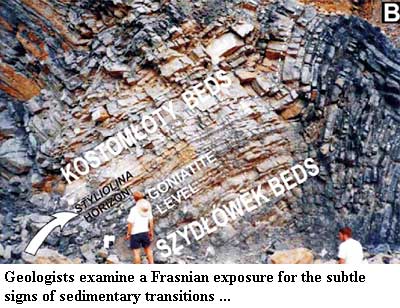 The
Devonian Mass Extinction
The
Devonian Mass Extinction
![]() Chemo-biostratigraphic
Study on the Devonian Frasnian-Famennian Event BAI Shunliang
Chemo-biostratigraphic
Study on the Devonian Frasnian-Famennian Event BAI Shunliang
As usual, a good first stop on the web is GeoWhen Database - Frasnian for latest dating and orientation in time, regional equivalents, etc.
Most serious web pages related to the Frasnian are concerned with the Frasnian-Famennian extinction -- the so-called Kellwasser Event(s). Among these are a completely unreasonable number of articles from Acta Paleontologica Polonica, including: Trilobites from the latest Frasnian Kellwasser Crisis in North ..., Chondrichthyan fauna of the Frasnian–Famennian boundary beds in Poland, and Frasnian–Famennian brachiopod extinction and recovery in southern .... Other journals are also sometimes represented: Geochemistry of the Frasnian-Famennian boundary in Belgium- Mass ..., White Rose Consortium ePrints Repository - Geochemical and ....
This is definitely not one of those periods for which one cannot find journal
articles on the web. In fact, the problem is finding anything else.
Rhenohercynian trilobites
has some nice images of Frasnian trilobites. The Devonian Times site has a
little on the tetrapods of the Frasnian (Devonian Times - New Directions).
Dr.
Jared Morrow (Univ. Northern Colo.) has a page with a great many useful
abstract and journal links, as well as basic stratigraphic information and the
like. Professor Grzegorz Racki
is probably one of the best-known names in Frasnian research, and his website
has even more links to work through. ATW050829.
| Page Back | Unit Home | Page Up | Page Top | Page Next |